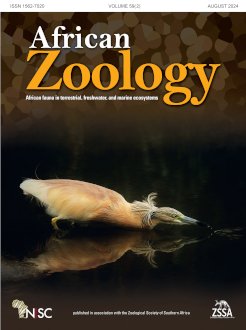The diet of the Cape genet Genetta tigrina is only well known in the coastal forests of South Africa, where either arthropods or small mammals are their dominant prey. Here, we aimed to demonstrate this species' opportunistic behaviour by investigating its feeding habits in the Albany Thicket Biome (Great Fish River Nature Reserve, Eastern Cape). We analysed 61 scats collected across the four seasons of the year deposited at 15 latrines by Cape genets, as confirmed through video-recordings. Small mammals were primary and arthropods secondary prey, respectively. We recorded seasonal variations in both percentage occurrence and volume of food remains, with peaks in consumption of small mammals in winter, and arthropods in spring–summer. The consumption of supplementary food items such as plant material was higher in spring and autumn, and particularly seeds/fruit in autumn. Reptiles and other food items occurred as trace foods throughout the year, although birds reached a peak in winter. Intermediate to high diet diversity and low to intermediate diet breadth indices were obtained for all seasons. Inter-seasonal diet overlap was intermediate to high depending on the diet descriptor and pairs of seasons considered. Cape genet is therefore a generalist opportunist forager that likely adjusts its diet according to seasonal variations in main prey availability, potentially leading to apparent seasonal or local “specialisms”.
How to translate text using browser tools
4 September 2024
Cape Genet Genetta tigrina Diet in the Albany Thicket Biome, South Africa
Axola Plaatjie,
Filipe Carvalho,
Rabelani Marikhele,
Zimkitha JK Madikiza,
Emmanuel Do Linh San
ACCESS THE FULL ARTICLE
<
Previous Article
|

African Zoology
Vol. 59 • No. 2
August 2024
Vol. 59 • No. 2
August 2024
Carnivora
diet
generalist opportunist forager
Genetta tigrina
scat analysis
seasonal variations





